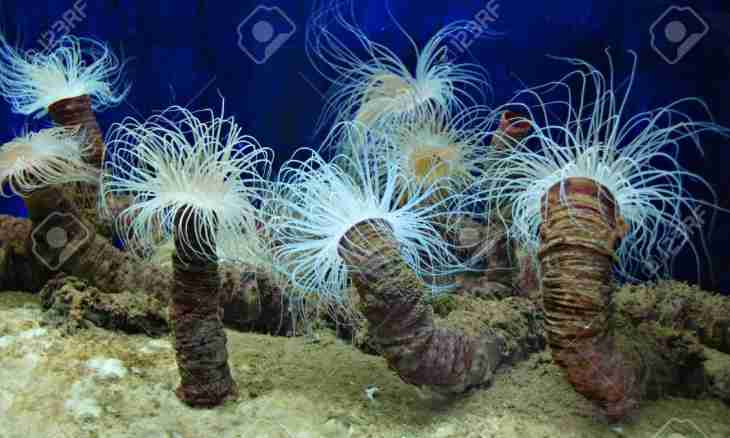Actinium or a sea anemone – fine coral - a polyp which belongs to the class of animals, but not plants. Close relatives of a being are jellyfishes. At a sea anemone a soft body which reminds a bright flower with petals instead of tentacles.
Building actinium
The being by means of a special nimbus on which there is a body with soft, long shoots moves. Around an oral disk numerous tentacles which form several rows are located and differ in appearance. Tentacles differ in the bright, various coloring and attract with beauty not only sea inhabitants, but also people. In case of danger, from each tentacle poisonous threads shoot.
The throat in an oral disk a forward stroke conducts to a stomach – a primitive tour cavity. The area of a mouth and leg is covered with the nervous terminations which react to external irritants or to foreign debris around an oral opening.
The nimbus sits on a cylindrical leg tight and the muscle consists of longitudinal ring. Thanks to these muscles, the leg bends or extended in different directions if necessary. The leg is called sometimes "sole".
Ways of movement
Depending on a species of an anemone, the sole performs different functions: sometimes it "crashes" into the earth, and sometimes emits mucous substance by means of which the anemone moves from place to place. Some types actinium have a special swimming bubble on a leg, and can float top tormashka (a sole up). In eternal swimming there passes all life. The look "sedentary" actinium is capable to move slowly. They do it not just like that, and in search of food or the solar place. Sedentary anemones can be rolled head over heels, having torn off a sole from the earth, or slowly creep on the ground as snails. The "digging" types of beings bury to the soil and do not move.
Everyday life of anemones
In height the anemones do not exceed 3 mm, diameter depends on a look – from 1 to 1.5 m. Lives actinium worldwide at any depth (sometimes casts them ashore). It is possible to meet the sea beauty in waters Black, the Sea of Azov.
Eat planktonama actinium, seaweed, sometimes small small fishes, can swallow stones and accidental garbage. Some types, having thought that ate something not that, throw out garbage back. Food preferences depend on a version. The lunch catches an anemone tentacles: widely opens them and immediately is enough production. Having nourishingly had dinner, actinium turns and hides tentacles. If something threatens life, the anemone produces poisonous threads.
Reproduction
Reproduction of anemones can be a miscellaneous: sexless, diclinous, the method of budding or fertilization in an oral disk is not excluded. Actinium differ in a lonely way of life, but in rare instances are going to colonies of the huge sizes. Some types fasten to a shell of cancer of the hermit. Cancer allows to eat up the remains of the food, as gratitude the anemone protects it from predators.

